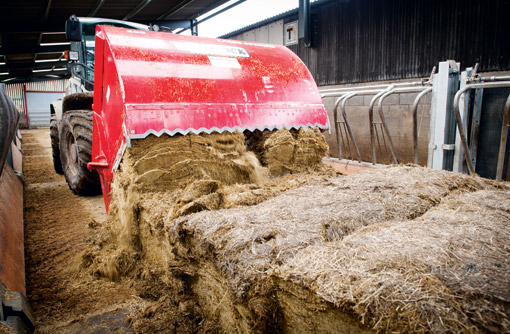Producers urged to check silage deterioration

Livestock producers are being urged to remain vigilant for potential silage problems following the cool growing season and late maize harvest.
Silage and TMR heating could become an issue this winter following the cool growing conditions and low sugar content of many grass silages, warned Katie Stephen from Frank Wright Trouw Nutrition.
“As a result of the cool growing season, the fermentation is slow which provides the ideal environment for spoilage bacteria and yeasts to proliferate. When exposed to oxygen when the clamp is opened they develop rapidly, causing the silage to heat up, leading to deterioration in feed quality,” she said.
To tackle this, she recommended minimising the amount of loose material on the clamp face, along with working to only remove thin wafers of feed at a time with either a block cutter or shear grab.
“Silage should be left exposed to the air as little as possible, so re-sheet the face wherever practical.”
In addition, she said it would be possible to spray an organic acid-based product on the face of the clamp every time silage was removed, to delay heating. But most importantly, farmers should dispose of any mould contaminated feed.
“It might be tempting to mix this silage in with better material to stretch stocks but the impact on intakes and performance could be considerable, so it is a false economy to try and feed contaminated material,” she added.
On top of all this, there is also an increased risk of acidosis due to high lactic acid levels in grass silage and a high fibre content in late harvested maize silage crops, said Roy Eastlake from Biotal.
He said about 18% of first-cut grass silage and 10% of second-cut grass silage had high levels of lactic acid of more than 100g/kg DM, and low-sugar grass silage increased the risk of acidosis.
“Many maize silages have good energy and starch contents but a significant proportion were harvested late leading to a higher fibre crop, reducing digestibility and starch degradability,” he added.
“Low-starch degradability can lead to reduced fibre digestion as rumen bugs are starved of energy. Supplementing with more rapidly fermented energy will help resolve this but again will increase the acidosis risk.”
As a result of these problems, he said “considerable care” was required when formulating rations, and adding fibre to the diet could help reduce acidosis by promoting rumination and saliva production.
“New research work also shows that adding live yeast can be more effective than the traditional rumen buffer sodium bicarbonate,” added Mr Eastlake.
“Yeast tackles the cause, not the symptom, and reduces pH by positively stimulating the growth of cellulolytic bacteria and reducing acid production.”
Tips for managing silage this season
• Take care when removing silage from the clamp; try to only remove thin wafers or feed at a time
• Re-sheet the face of the silage clamp where possible, to reduce spoilage
• Dispose of any mould-contaminated silage
• Supplement late-cut maize silage by adding fibre to promote rumination and saliva production
• Consider the use of live yeasts in the diet to reduce rumen pH and get on top of acidosis.
